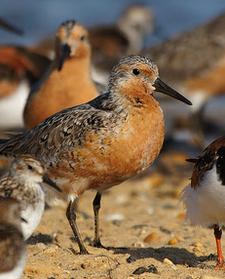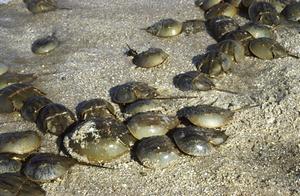 為了保護大西洋海岸的鱟,同時在德拉威海岸讓候鳥易於取得鱟卵,馬里蘭州自然資源部3月17日表示將施行一個鱟魚雄雌2:1的產量比例,由4月1日開始生效,現有的計畫並沒有性別比率的限制。
為了保護大西洋海岸的鱟,同時在德拉威海岸讓候鳥易於取得鱟卵,馬里蘭州自然資源部3月17日表示將施行一個鱟魚雄雌2:1的產量比例,由4月1日開始生效,現有的計畫並沒有性別比率的限制。
這個行動將會立即增加2009年5月和6月在德拉威灣附近的候鳥對鱟卵的易得性 「該部門負責保育和管理我們的自然資源,」自然資源部的部長歐克尼爾(Tom O'Connell)表示,「我們也認知到大西洋的水手和海鮮加工者對於鱟的依賴性,並相信這是一個嚴謹的計畫,可以平衡這樣的需求,同時確保後代也有機會目睹德拉威灣鱟和海岸候鳥的稀有景象。」
自然資源部執行了一個技術分析,並評估了在管理議題上的公眾意見,包含在執行性別限制之前,禁止捕撈雌鱟。
馬里蘭的水手,同時是鱟、海螺和海鰻的捕撈者,通常使用鱟當作誘餌,他們的作業會被這項行動所影響,但是仍會維持他們目前的捕撈額度。
「這是一個重要的一步,可以保留更多極度重要的鱟卵在海灘上,讓長途向北遷徙的紅腹濱鷸補給體力,」美國鳥類保育協會的副執行長史絡德(Darin Schroeder)表示。
 紅腹濱鷸是一種紅棕色的海岸候鳥,體型和鴿子差不多,每年由南美的南端的Tiera Del Fuego遷徙9300英里回到其繁殖地-加拿大北極圈,在春天時紅腹濱鷸停留在大西洋海岸以德拉威灣上的鱟卵為食,重新養足體力。
紅腹濱鷸是一種紅棕色的海岸候鳥,體型和鴿子差不多,每年由南美的南端的Tiera Del Fuego遷徙9300英里回到其繁殖地-加拿大北極圈,在春天時紅腹濱鷸停留在大西洋海岸以德拉威灣上的鱟卵為食,重新養足體力。
但是科學研究發現海灘上的鱟卵數量正在減少,使得美國漁業暨野生動物局做成了結論:「威脅紅腹濱鷸最主要的因素是破壞和改變棲地,特別是由於鱟數量減少進而造成的食物來源減少。」
由於2008年度紅腹濱鷸抵達繁殖地的比率減少了15%,相較於1985-2007的結果更是減少了75%,漁業暨野生動物局已經提高了該物種的優先考慮順位。2007年只有14800隻紅腹濱鷸抵達該物種的主要過冬地區。
1999年紅腹濱鷸在紐澤西州的州法之中被列為瀕臨絕種動物名單,由於2006秋天所做的紅腹濱鷸現狀評估報告,美國漁業暨野生動物局宣布紅腹濱鷸是列入聯邦名單以及瀕臨絕種野生生物現狀委員會的候選者。在加拿大紅腹濱鷸已在2007年4月建議被列為瀕臨絕種生物。
在2008年3月,紐澤西的州長科新執行了該州暫停採收鱟的禁止令。
即使鱟(horseshoe crab)英文名中有個「蟹(crab)」,鱟事實上比較接近蜘蛛和蠍子。他也是地球上最老的生物之一,在恐龍出現的1億年就已出現了,這份資料根據德拉威海優良學院計畫大學,現在世界上鱟數量最多的地方就是德拉威海灣了。
To protect the Atlantic coast population of horseshoe crabs and increase the availability of horseshoe crab eggs in Delaware Bay to migratory shorebirds, the Maryland Department of Natural Resources said today it is implementing a 2:1 male to female horseshoe crab harvest ratio, effective April 1st. There is currently no sex ratio limit.
This action will immediately increase the availability of horseshoe crab eggs to migratory shorebirds in Delaware Bay this May and June.
"The Department is responsible for the conservation and management of our natural resources," said Tom O'Connell, director of the DNR Fisheries Service. "We also recognize the increasing dependency of horseshoe crabs to Ocean City watermen and seafood processors, and believe this is a prudent action that balances these needs while ensuring future generations have the opportunity to experience the Delaware Bay phenomenon between horseshoe crabs and shorebirds."
The DNR conducted a technical analysis and reviewed public input on a range of management options, including closure of the female horseshoe crab fishery, before imposing this limit.
Maryland watermen, both horseshoe crab harvesters and conch and eel fishermen who use horseshoe crabs as bait, will be affected by this action but will retain their current harvest quota.
"This is a strong step in the right direction in ensuring more critically important horseshoe crab eggs will be on the beach when Red Knots stop to refuel on their long migration northward," said Darin Schroeder, vice president of conservation advocacy for American Bird Conservancy.
The red knot, Caladris canutus rufa, a reddish-brown shorebird about the size of a dove, annually migrates 9,300 miles from Tiera Del Fuego at the southern tip of South America to its breeding grounds in the Canadian Arctic. In spring red knots stop on the Atlantic shore to rebuild their energy reserves by feasting on horseshoe crab eggs in Delaware Bay.
But scientific studies have shown that the number of available horseshoe crab eggs has dropped, leading the U.S. Fish and Wildlife Service to conclude that, "The primary factor threatening the red knot is destruction and modification of its habitat, particularly the reduction in key food resources resulting from reductions in horseshoe crabs."
Due to a 15 percent decline in red knot numbers at the species' wintering grounds in the past year, and a 75 percent decline from 1985 to 2007, the Fish and Wildlife Service has increased the listing priority for the species. Only 14,800 red knots were counted in 2007 at the species' primary wintering areas.
In 1999, the red knot was listed as a threatened species in New Jersey under state law. As a result of the Red Knot Status Assessment in fall 2006, the U.S. Fish and Wildlife Service announced the red knot as a candidate for federal listing and the Committee on the Status of Endangered Wildlife. In Canada recommended listing the red knot as endangered in April 2007.
In March 2008, New Jersey Governor Jon Corzine imposed a moratorium on harvesting horseshoe crabs in that state.
Although called a "crab," the horseshoe crab is actually closely related to spiders and scorpions. It is also one of the Earth's oldest creatures, having appeared 100 million years before the dinosaurs, according to the University of Delaware Sea Grant College Program. The largest population of horseshoe crabs in the world lives in Delaware Bay.






